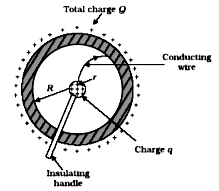Van de Graaff generator is a machine that can build up high voltages of the order of a few million volts (107 V). The resulting large electric fields are used to accelerate charged particles (electrons, protons, ions) to high energies needed for experiments to probe the small scale structure of matter.
Principle : The working of Van de Graaff generator is based on the principle of electrostatic induction and action of points.
Suppose we have a large spherical conducting shell of radius R, on which we place a charge Q. This charge spreads itself uniformly all over the sphere. The field outside the sphere is just that of a point charge Q at the centre; while the field inside the sphere vanishes. So the potential outside is that of a point charge; and inside it is constant, namely the value at the radius R. We thus have: Potential inside conducting spherical shell of radius R carrying charge Q = constant.


Now, let us suppose that in some way we introduce a small sphere of radius r, carrying some charge q, into the large one, and place it at the centre (fig. (a). The potential due to this new charge clearly has the following values at the radii indicated: Potential due to small sphere of radius r carrying charge q

Taking both charges q and Q into account we have for the total potential V and the potential difference the values

Assume now that q is positive. We see that, independent of the amount of charge Q that may have accumulated on the larger sphere and even if it is positive, the inner sphere is always at a higher potential: the difference V(r )–V(R) is positive. The potential due to Q is constant upto radius R and so cancels out in the difference! This means that if we now connect the smaller and larger sphere by a wire, the charge q on the former will immediately flow onto the matter, even though the charge Q may be quite large. The natural tendency is for positive charge to move from higher to lower potential. Thus, provided we are somehow able to introduce the small charged sphere into the larger one, we can in this way keep piling up larger and larger amount of charge on the latter. The potential (Eq.1) at the outer sphere would also keep rising, at least until we reach the breakdown field of air.
Using this principle, the van de Graaff generator capable of building up potential difference of a few million volts, and fields close to the breakdown field of air which is about 3 × 106 V/m. A schematic diagram of the van de Graaff generator is given in Fig.

Construction :
A large spherical conducting shell (of few metres radius) is supported at a height several meters above the ground on an insulating column. A long narrow endless belt insulating material, like rubber or silk, is wound around two pulleys –one at ground level, one at the centre of the shell. To avoid the leakage of charges from the sphere, the generator is enclosed in the steel tank filled with air or nitrogen at very high pressure (15 atmospheres).
Working :
The belt is kept continuously moving by a motor driving the lower pulley. It continuously carries positive charge, sprayed on to it by a brush at ground level, to the top. There it transfers its positive charge to another conducting brush connected to the large shell. Thus positive charge is transferred to the shell, where it spreads out uniformly on the outer surface. In this way, voltage differences of as much as 6 or 8 million volts (with respect to ground) can be built up.
Uses :
Van de Graaff Generator is used to produce very high potential difference (of the order of several million volts) for accelerating charged particles.
(1) The beam of accelerated charged particles are used to trigger nuclear reactions.
(2) The beam is used to break atoms for various experiments in Physics.
(3) In medicine, such beams are used to treat cancer.
(4) It is used for research purposes.